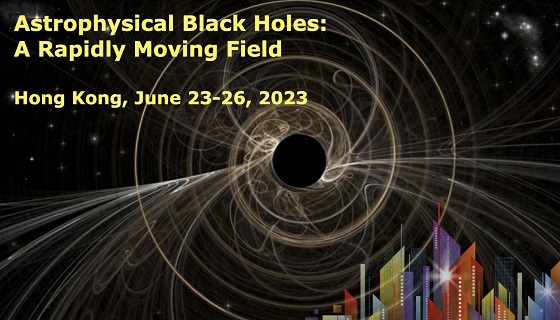Session:- Gravitational Waves.1
Theoretical and observational studies of astrophysical black holes have been in rapid development in recent decades. This conference will present major breakthroughs and key remaining questions concerning our fundamental understanding of astrophysical black holes, such as the formation and collimation of relativistic jets, the accretion and growth of black holes, the measurement of black hole spin, the merger of black holes, the first images of black hole shadow, the particle acceleration mechanisms and transient phenomena around black holes, and the feedback from massive black holes to galaxies.
◎Why are LIGO/Virgo black holes so massive?
Measuring the mass and distance of a Gravitational Wave(GW) source is a fundamental problem in GW astronomy. The issue is becoming even more pressing since LIGO and Virgo have detected massive black holes that in the past were thought to be rare, if not entirely impossible. The waveform templates used in the detection are developed under the assumption that the sources are residing in a vacuum, but astrophysical models predict that the sources could form in gaseous environments, move with relatively large velocity, or reside in the vicinities of supermassive black holes. In his talk, the speaker will show how the above environmental factors could distort the GW signals and result in a biased estimation of the physical parameters, such as mass and distance. In particular, he will highlight the ubiquity of such a bias among the LIGO/Virgo sources formed in active galactic nuclei. If not appropriately accounted for, the above bias may alter our understanding of the formation and evolution of the black holes found via gravitational waves.
時間:2023.06.26(一) 09:30~09:48
講者:Prof. CHEN, Xian 陈弦 教授 (Peking University)
↓
↓
◎Accretion flows in AGN dominated by feedback from embedded black holes
The speaker presents new two-fluid models of accretion disks in Active Galactic Nuclei(AGN) that aim to resolve the long-standing problem of Toomre instability in AGN outskirts. In the spirit of earlier work by Sirko Goodman 2003 and others, the speaker and his research team argue that Toomre instability is eventually resolved via feedback produced by fragmentation and its aftermath. Unlike past semi-analytic models, which
(i) adopt local prescriptions to connect star formation rates to heat feedback, and
(ii) assume that AGN disks self-regulate by star-forming,
they find that feedback processes are both temporally and spatially non-local. The accumulation of many stellar-mass Black Holes(BHs) embedded in AGN gas eventually displaces stellar winds and supernovae as the dominant feedback source. The non-locality of feedback heating, in combination with the need for heat to efficiently mix throughout the gas, gives rise to steady-state AGN solutions that can have a Toomre parameter much greater than 1 and no ongoing star formation. They explore the implications of our two-fluid disk models for the evolution of compact object populations embedded in AGN disks, and find self-consistent solution in much of the parameter space of AGN mass and accretion rate. These solutions harbor large populations of embedded compact objects which may grow in mass by factors of a few over the AGN lifetime, including into the lower and upper mass gaps. These feedback-dominated AGN disks are significantly different in structure from commonly used 1D disk models, which has broad implications for gravitational wave source formation inside AGN.
時間:2023.06.26(一) 09:48~10:06
講者:GILBAUM, Shmuel (Hebrew University of Jerusalem)
↓
↓
◎The susceptible GW sources in the AGN accretion disk
Extreme-Mass-Ratio Inspirals(EMRIs) and Intermediate-Mass-Ratio Inspirals(IMRIs) are important Gravitational-Wave(GW) sources for the Laser Interferometer Space Antenna(LISA). So far, their formation and evolution are considered to be independent, but recent theories suggest that stellar-Mass Black Holes (sBHs) and Intermediate-Mass Black Holes (IMBHs) can coexist in the accretion disk of an Active Galactic Nucleus(AGN), which indicates that EMRIs and IMRIs may form in the same place. In this presentation, the speaker will talk about their study on the interaction between a gap-opening IMBH in an AGN disk and the sBHs surrounding it, motivated by the fact that a gas giant migrating in a protoplanetary disk could trap planetesimals close to its orbit. They analyze the torques imposed on the sBHs by the disk as well as by the IMBH, and show that the sBHs can be trapped by the IMBH if they are inside the orbit of the IMBH. They implement the torques in their numerical simulations to study the migration of an outer IMBH and an inner sBH, both embedded in an AGN disk. The research team finds that their migration is synchronized until they reach a distance of about ten Schwarzschild radii from the central supermassive black hole, where the pair break up due to strong GW radiation. This result indicates that LISA may detect an EMRI and an IMRI within several years from the same AGN. Such a GW source will bring rich information about the formation and evolution of sBHs and IMBHs in AGNs.
時間:2023.06.26(一) 10:06~10:24
講者:Peng Peng (Peking University)
↓
↓
地點:香港大學 百週年校園 CPD 3.04 Centennial Campus
語言:英語
是會議作坊,參加者必須登記,2023.04.30 截止
【此屬轉載訊息,以主事單位發佈為準】
此活動由香港大學物理系主辦。
https://astrobh.physics.hku.hk/event/3/timetable/#all.detailed


